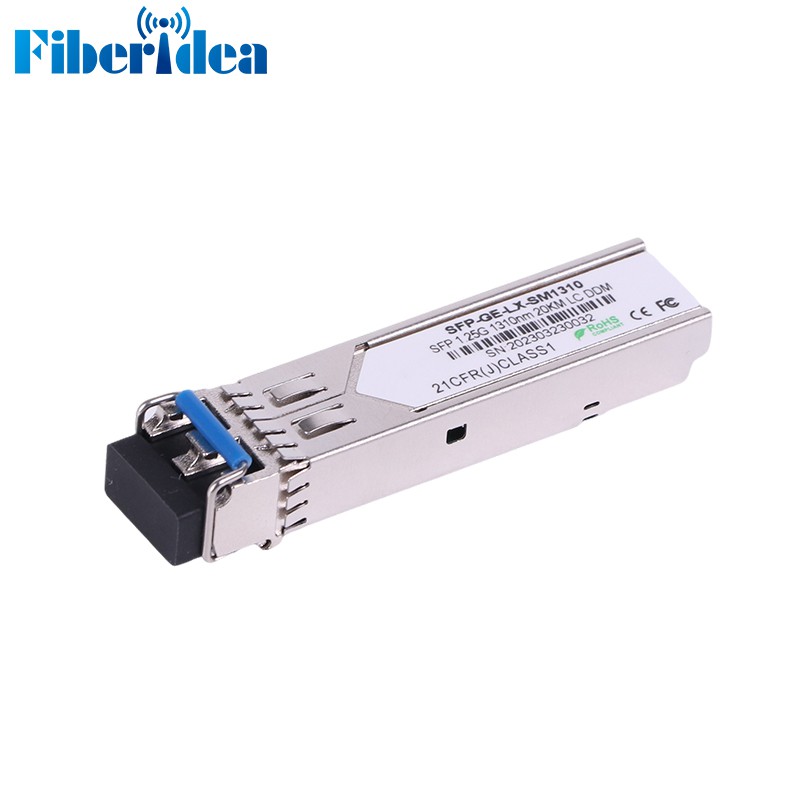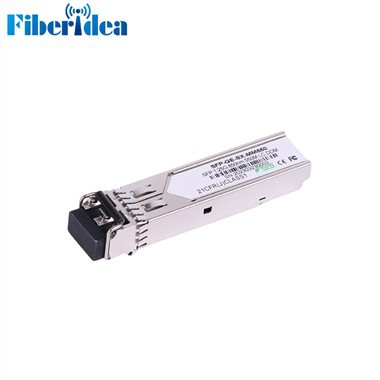1.25g 1310nm 40km Lc SFP
SFP is an interface device that converts gigabit electrical signals into optical signals. It is an industry-standard small and pluggable gigabit optical transceiver module. It can be used on SFP ports of network devices such as switches, routers, and media converters. Used to connect optical or copper network cables for data transmission, commonly found in Ethernet switches, routers, firewalls and network interface cards Optical and Electrical Characteristics
|
Parameter |
Symbol |
Min |
Typical |
Max |
Unit |
Notes |
||
|
Transmitter |
||||||||
|
Centre Wavelength |
λc |
1260 |
1310 |
1360 |
nm |
|
||
|
Spectral Width (RMS) |
∆λ |
|
|
4 |
nm |
|
||
|
Average Output Power |
Pout |
-9 |
|
-3 |
dBm |
1 |
||
|
Extinction Ratio |
ER |
9 |
|
|
dB |
|
||
|
Optical Rise/Fall Time (20%~80%) |
tr/tf |
|
|
0.26 |
ns |
|
||
|
Data Input Swing Differential |
VIN |
400 |
|
1800 |
mV |
2 |
||
|
Input Differential Impedance |
ZIN |
90 |
100 |
110 |
Ω |
|
||
|
TX Disable |
Disable |
|
2 |
|
Vcc |
V |
|
|
|
Enable |
|
0 |
|
0.8 |
V |
|
||
|
TX Fault |
Fault |
|
2 |
|
Vcc |
V |
|
|
|
Normal |
|
0 |
|
0.8 |
V |
|
||
|
Receiver |
||||||||
|
Centre Wavelength |
λc |
1260 |
|
1580 |
nm |
|
||
|
Receiver Sensitivity |
|
|
|
-23 |
dBm |
3 |
||
|
Receiver Overload |
|
-3 |
|
|
dBm |
3 |
||
|
LOS De-Assert |
LOSD |
|
|
-24 |
dBm |
|
||
|
LOS Assert |
LOSA |
-30 |
|
|
dBm |
|
||
|
LOS Hysteresis |
|
1 |
|
4 |
dB |
|
||
|
Data Output Swing Differential |
Vout |
400 |
|
1800 |
mV |
4 |
||
|
LOS |
High |
2 |
|
Vcc |
V |
|
||
|
Low |
|
|
0.8 |
V |
|
|||
|
Bsolute Maximum Ratings |
||||
|
Parameter |
Symbol |
Min |
Max |
Unit |
|
Storage temperature |
TS |
-40 |
85 |
°C |
|
Power Supply Voltage |
Vcc |
-0.5 |
4 |
V |
|
Relative Humidity |
RH |
5 |
95 |
% |
|
Signal Input Voltage |
|
-0.3 |
Vcc+0.3 |
V |
|
Receiver Damage Threshold |
|
5 |
|
dBm |
SFP Module Single Mode VS Multimode
Single mode fiber is ideal for long-distance applications as it can maintain signal quality over longer distances without signal attenuation or dispersion. It is commonly used in telecommunications, data centers and other network applications that require high bandwidth over very long distances. Single mode SFP modules are also typically more expensive than multimode modules, but the longer range and higher bandwidth capabilities justify the cost.
On the other hand, multimode fiber is suitable for shorter-distance applications and shorter lengths of fiber. It is usually less expensive than single mode fiber and is commonly used in local area networks, data centers and other network applications that require less bandwidth over shorter distances. Multimode SFP modules are also easier to install and maintain, and can support a range of wavelengths and data rates.
Ultimately, the choice between single mode and multimode SFP modules depends on the specific needs of the network and the distance over which the signal needs to be transmitted. Both options have their own unique benefits and can help to enhance the performance and reliability of your network. So whether you choose to go with single mode or multimode, SFP modules are a reliable and cost-effective way to upgrade your network connectivity.
Some people also ask 1000base-lx sfp is singlemode or multimode? 1000BASE-LX corresponds to the 802.3z standard, and can use both single-mode fiber and multi-mode fiber.
Hot Tags: 1.25g 1310nm 40km lc sfp, China 1.25g 1310nm 40km lc sfp manufacturers, factory, sfp onu, sc sfp, 1 25G 850nm 550m SFP Transceiver, 2 5G 1550nm 80KM Lc SFP, LC SFP Transceiver, 1490NM 1310NM sfp
Previous
1.25g 1550nm 80km Lc SFPYou Might Also Like
Send Inquiry













